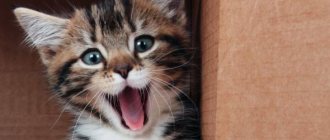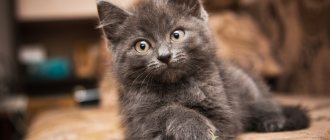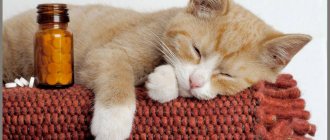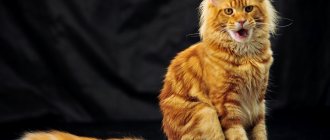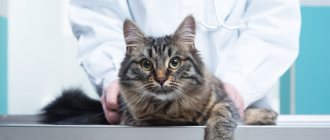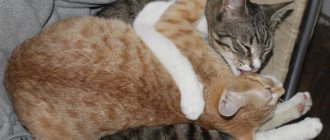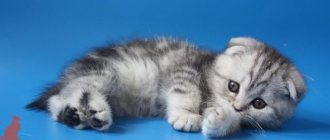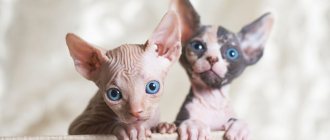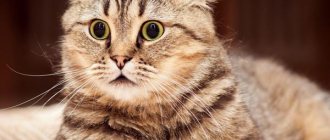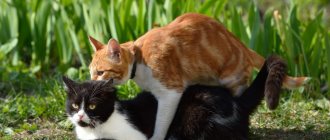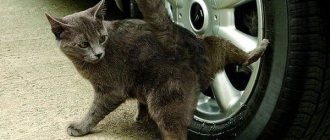Cats teeth
In most cases, kittens are born without teeth. There are exceptions to this rule, but they are extremely rare. At the age of 4-5 weeks, the kitten begins to cut its first teeth. The first set consists of 26 pieces (14 on the upper jaw and 12 on the lower jaw). As a rule, by two months the growth process is completed. By this time, healthy young cats can feed themselves and can be given solid food. They can also suckle from a cat; this usually does not cause discomfort to mothers.
Milk teeth are covered with white enamel, they themselves are sharp and quite thin. There are six incisors on the front of the jaws, followed by canines - one on each side. After them, premolars and molars grow, three on the lower jaw and two on the upper. The sequence of eruption is as follows: first the incisors appear, then the canines, and then the molars.
When the process of growth of the first, milk teeth is completed, the kittens are sent to a new place of residence (if the owner intends to do so). Before this, the first vaccinations are given and the necessary documents are completed.
It is necessary to sell or give away a kitten before the change of milk teeth to permanent ones begins.
Moving is stressful for an animal, and, in addition, during the process of replacing teeth, its body is weakened, so it is advisable to separate these two events in time. It is better for the animal if the shift begins when it has already become accustomed to its new place of residence and owners.
What to do and how to relieve the kitten’s discomfort?
It is recommended to buy special chewing toys for the kitten during the change of teeth.
When pets change their teeth, they often experience pain that does not allow them to live their previous lives. If a cat’s fang or molars are protruding, then to alleviate the discomfort, owners are advised to purchase special rodents or bones from the pet store, on which the animal can scratch its gums. For this reason, as soon as a kitten’s tooth falls out, it is worth removing all electrical appliances, shoes and other items that the baby can damage. If a cat experiences increased salivation when changing teeth, then no measures should be taken. In most cases, this symptom does not cause discomfort to the kitten. If his face is constantly wet, then periodically it can be wiped with a soft cloth or dry cloth.
When a kitten's teeth grow, its body may be constantly in a state of stress. Owners are advised to treat the baby with special attention, surround him with love, care and attention. Frequent contact with your pet and various games will distract him from changing teeth and reduce discomfort. During this process, the pet often rubs against the corners of furniture or the owner’s legs. You shouldn’t forbid him to do this, because with such actions he is trying to calm himself down and scratch his gums. It is also important to pay attention if these signs are not observed, as they may indicate a problem, so it is recommended to take the kitten to the vet.
Changing teeth in kittens
At about 15-16 weeks of age, baby teeth begin to fall out and are replaced by molars. This happens in the same way as when the first set appears: first the baby teeth fall out and new incisors grow, then the lower, and then the upper canines, then the premolars and molars. The only difference is that in adult cats the full set consists of 30 teeth: 2 pieces are added on each jaw, 1 on each side.
The change process is completed at approximately seven months of age. Just like humans, cats have second molars that serve them throughout their lives. In order for them to be fully preserved in old age, the cat’s oral cavity must be properly cared for.
Permanent teeth
An adult cat has a set of thirty dente teeth; after changing the milk teeth, the molars are additionally erupted, so the symptoms of gingivitis may persist. There are the following types of adult cat teeth:
- Incisors. Small teeth located on the front of the jaws. Their purpose is to capture and preserve prey. They do not take part in chewing. A healthy cat's dental kit includes 12 incisors - 6 each on the upper jaw and mandible. These are the most vulnerable dentures: they are held by a single root, shallowly buried in the jaw bones, and are lost with age.
- Fangs play a decisive role in tearing apart caught prey. They are single-rooted dente, which are quite deep in the jaw. The cat has four fangs located adjacent to the incisors.
- Premolars, or small molars, are present in a cat in the amount of ten teeth. Adjacent to fangs. Their number on the upper and lower jaws is not the same: six at the top, four at the bottom. Designed for chewing and crushing solid food. Equipped with two or three roots. This anatomical feature complicates the work of a veterinary dentist: one of the radicles may remain in the jaw when removed. Before extracting a premolar, an x-ray is prescribed.
- Molars (large molars), four in number, border the edges of the jaws. Designed for chewing meat and solid feed. The upper ones have a single short root. The lower ones have two roots, so removing them may be difficult.
In order for a cat to develop healthy teeth, a balanced diet is necessary. Ready-made products for kittens are considered the best option. Otherwise, you will have to use vitamin and mineral supplements. The change in dente is accompanied by an irresistible desire to chew something. To protect household items from being torn apart by a growing cat, and the animal from getting inedible objects into the food channel, you need to purchase a toy.
If the owner notices a fallen tooth, it would be useful to ask whether there is a wound or pus in this place.
Symptoms of tooth change
The owner may not notice the loss of incisors at first: they are very small. And cats are designed in such a way that they swallow small objects that end up in their mouths rather than spit them out. In addition, if the process goes well, then the kitten does not experience much discomfort and does not complain to the person.
The only normal symptom is itching of the gums, which the kitten tries to relieve by scratching them on something. During this period, wires, furniture, clothing, shoes and other things suffer. Also, teething is accompanied by copious salivation.
The appearance of permanent teeth occurs gradually. The root presses on the milky one, dissolving its weak roots in a few days. The top of the milky one falls out, and the root one begins to grow. During this period, the gums become slightly inflamed and swollen. When the permanent tooth erupts, it becomes normal.
During the period of teeth change, the kitten may show poor appetite, as it most likely experiences discomfort when chewing. In some cases, animals develop a short-term fever: the temperature rises slightly, and the cat tries to warm up, looking for warmer places.
It happens that the permanent tooth is already visible, but the milk tooth has not yet fallen out. If the latter does not interfere with the growth of the former, and the teeth do not injure the oral mucosa, then there is no need to worry. After some time, the milk will fall out. They normally do not harm each other, since they grow from separate holes.
Main symptoms of new teeth erupting
Sometimes kittens develop milk teeth within the first day after birth, and when new ones emerge, no unpleasant signs or discomfort are noted. If the process of changing teeth occurs painlessly, then there is no need to do anything. But when the baby develops restlessness and unpleasant symptoms, the help of a veterinarian may be required. Contacting a veterinary clinic is necessary if a kitten’s fang has fallen out and the following symptoms are recorded:
If unpleasant symptoms occur during the change of baby teeth, you should consult a specialist.
- Disgusting odor from the mouth. A healthy cat teething without an unpleasant odor from the mouth, and the presence of such an odor signals an inflammatory reaction and the progression of periodontal disease.
- Poor sleep and refusal to eat. Similar symptoms when changing teeth in a kitten are the result of severe pain. The pet is constantly restless and apathetic. It is necessary to try to feed the kitten at least once a day when teething, so that additional health problems do not arise.
- Copious secretion of saliva. The consistency of the liquid changes, it becomes thick and constantly hangs out of the kitten’s mouth, as a result of which the fur on the chest is constantly wet. Such signs indicate inflamed oral mucosa and stomatitis.
It is necessary to contact a veterinarian if, after 2 years of age, the cat’s primary canines have not been renewed or permanent teeth have begun to fall out. Help is also required if the change of dentition is accompanied by double eruption of some teeth. This problem can be solved by pulling out baby teeth. If the problem is not solved in time and the double dentition is not removed, then there is a high risk of severe inflammation, purulent process and the development of other complications.
Caring for a kitten during the period of teeth change
During the period of changing teeth, kittens' gums itch very much, just like people's gums (if adults remember this feeling). They try to chew on something to reduce the level of discomfort. At this time, owners need to be especially careful: the animal can harm itself, for example, by chewing electrical wires. There is also a danger of choking on a small object on which the kitten decided to scratch its gums. It is necessary to remove all such small items, wiring and other potentially dangerous things from the cat’s access area.
It is also necessary to pay attention to several issues: vaccination, nutrition and oral hygiene.
Nutrition
It is better to consult a veterinarian about the nutrition of a kitten during the period of teeth change. To build teeth, the animal’s body requires large amounts of calcium and phosphorus, so these elements can be slightly increased in the diet. However, you cannot overdo it: this is a serious burden on the kidneys. If parents or siblings had problems with the excretory system, then there is no need to introduce additional calcium and phosphorus.
If the kitten is accustomed to industrially produced food, then it should be fed dry food during this period. This will allow the pet to scratch its gums and, possibly, remove already loose teeth. There is no great danger in kittens swallowing teeth, but sometimes swallowed solids can harm the soft tissues of the digestive tract.
If the kitten has a natural diet, then it is recommended to give relatively large pieces of dietary meat. You can give fish twice a week, but you shouldn’t especially get used to such food. This is especially true for male kittens who are supposed to be castrated. In the future, fish will have to be completely excluded from the diet, and the animal should not get used to it.
You should also give your kitten plenty of dairy products rich in calcium. This can be cottage cheese, whole milk (if the animal tolerates it normally), yogurt, kefir with a low fat content.
In specialized stores you can find special bones that a kitten can chew on when its gums itch. In addition to the fact that it eliminates discomfort and helps teething, such products also contain useful additives that will improve the kitten’s health.
Vaccinations
Kittens should be vaccinated according to the schedule. The first vaccinations are given at two months; further procedures should be consulted with a veterinarian. As for vaccination during the period of teeth change, all veterinarians agree on this issue: while the milk teeth are falling out and the molars are growing, there is no point in getting vaccinated.
A visit to the veterinary clinic is stressful for the animal. And during the period of changing teeth, the kitten already feels somewhat weakened, even if everything is going fine. Therefore, vaccinations should be done before they begin to fall out, and then after the root ones grow.
Oral hygiene
To prevent tartar and other diseases of the oral cavity, teeth and gums, cats should brush their teeth regularly. Experts advise accustoming the animal to this procedure from infancy: then it will not experience discomfort, will get used to it and, perhaps, will even love cleaning.
Kittens need to brush their teeth with a special toothpaste and brush. Human toothpastes are not suitable for cats as they contain ingredients that are harmful to them. Each family member should have their own brush. There are also special gels for disinfecting the oral cavity for cats.
This should be done approximately once every three weeks. During the shift, you can purchase a special product containing anti-inflammatory and anesthetic components. Procedures with such a gel will significantly reduce the animal’s discomfort.
How to care for your pet while changing teeth
It is important to understand that changing teeth in a kitten is not a disease. He doesn't need any special privileges. Usually this process is painless, with the exception of pathologies. In this case, you must contact your veterinarian and follow his recommendations.
Nutritional Features
Feeding your baby should be appropriate for his age, regardless of the process of changing teeth. It is worth remembering that phosphorus and calcium ensure normal tooth growth. In order for these microelements to be absorbed, vitamins A and D are needed. If the food is not rich in these substances, then specialized supplements are required. Other vitamins will also not be superfluous, since during the period of teeth change the kitten’s immunity weakens. The baby must be given:
- dairy products;
- a variety of lean meats;
- rarely lean boiled fish;
- oatmeal, rice;
- carrots, zucchini and pumpkin.
If you choose ready-made food for feeding, then you should pay attention to products specifically designed for kittens. High-quality food contains all the vitamins and microelements necessary for the development of a kitten, and is also balanced taking into account the needs of the growing body.
Royal Canin Kitten food is suitable for kittens up to 12 months of age
How to behave with a pet
Despite the fact that the animal experiences a little stress due to itching in the gums, you should not allow the baby to chew on anything. You especially shouldn’t allow him to play with his hands, otherwise the kitten may get used to it and this will turn into a problem at an older age. It is advisable to purchase several diverse toys that involve both joint play with the baby and independent play.
At any age, a cat needs affection. You cannot ignore the baby or brush him off.
Features of care
The time when teeth begin to change is accompanied by gum inflammation. To alleviate the condition, you can use a gel that has an anti-inflammatory and analgesic effect.
Gel Strong Teeth is indicated for inflammatory processes and teething
When changing teeth, you cannot vaccinate your baby, as vaccination can cause health problems due to weakened immunity. If the time for scheduled vaccination is approaching, it is better to postpone it for 25–30 days.
In what cases is it necessary to contact a veterinarian?
The change of teeth occurs gradually, and it is necessary to regularly examine the kitten’s oral cavity. If the gums are pink, there is no inflammation or redness in the places where soft tissue joins the bone, and baby teeth do not interfere with the growth of permanent teeth, then there is no reason to worry. You should contact your veterinarian if you notice the following problems:
- there is redness around the baby tooth or the hole where it was located;
- pus appeared in the hole from the fallen tooth;
- a very strong unpleasant odor comes from the mouth;
- there is inflammation on the gums;
- the new tooth grows in such a way that it damages the mucous membrane, due to the fact that it is interfered with by the milk tooth or for another reason;
- The radical ones have grown, but the milk ones have not completely fallen out, and the shift time has ended.
You should also pay attention to the well-being and behavior of your pet. Warning signs:
- the kitten is apathetic, does not play;
- a plaintive meow, indicating serious discomfort and pain;
- the animal eats poorly or refuses to eat at all;
- anxiety, poor sleep.
Sometimes owners notice that the tray is empty for more than a day. This is also a cause for concern. The absence of bowel movements may be due to the fact that the kitten was trying to scratch its teeth and swallowed some object that blocked the intestinal lumen.
The owner should be aware that during the period of changing teeth, kittens' immune defenses are somewhat reduced, so changes in behavior may be due to the fact that the animal has contracted an infection. This can also happen to a kitten who lives in the house and is not outside. Owners can bring pathogenic flora into the apartment on shoes or clothes. Usually it is not dangerous for either animals or humans, however, against the background of a decrease in the immune status, the cat may get sick. Not everyone has been vaccinated by this age, and the animal does not have specific immunity to certain pathogens.
Changing baby teeth to permanent ones
At the age of three months, kittens begin to lose their milk teeth, gradually being replaced by molars . This process is usually complete by six or seven months, but don't worry if it takes longer for your kitten. Such deviations are usually associated with the breed of cat or characteristics of individual development.
The order of changing teeth should not be disturbed. The first to be replaced are the incisors, then the canines, and lastly the molars and premolars are replaced.
However, if a new tooth grows on a baby tooth and this causes discomfort to the pet, then you should definitely consult a specialist. If such growth does not bother the animal, then a visit to the veterinarian can be postponed, since baby teeth can calmly and painlessly fall out even after the main shift.
Teeth change schedule
A healthy adult cat should have thirty permanent teeth: twelve incisors, four canines, ten premolars and four molars. Each of them serves her for a specific purpose, for example, incisors are needed to tear food, fangs help to capture prey, and so on.
A cat's permanent dental formula is formed after six months. It includes: on top - three incisors, one canine, three premolars, one molar; below - three incisors, one canine, two premolars, one molar. When calculating, all coefficients are doubled, so the total is thirty permanent teeth.
This is what the jaw of an adult healthy cat should look like with timely and correct teeth replacement.
Table: schedule for the eruption of permanent teeth and their functions
| Teeth | Quantity (lower/upper jaw) | Period of eruption | Function |
| Incisors | 6/6 | 3.5–4.5 months | Grabbing |
| Fangs | 2/2 | 5 months | Tearing |
| Premolars | 6/4 | 4.5–6 months | Chopping |
| Molars | 2/2 | 4–5 months | Chopping |
Symptoms of tooth change
The process of changing teeth can begin and even end unnoticed by you, since the kitten usually does not experience pain. Most often, the change of teeth becomes obvious when a lost baby tooth is found.
Nevertheless, there are a number of symptoms that will help you navigate and notice in time the process of changing teeth:
- When a kitten's teeth change, an unpleasant odor may appear from the mouth, which is often associated with poor nutrition. There is no need to do anything about this, it will quickly disappear once the teeth renewal process is completed.
- Kittens may experience discomfort during the actual cutting of new teeth, so the animal's behavior will change slightly. For example, a slight increase in temperature is likely (the norm is a temperature of 38 ° C to 39 ° C, for small kittens a higher temperature of up to 39.5 ° C is typical). As a result, the kitten feels the cold more strongly and tries to spend more time next to the warm body of the owner: on the lap or in the arms. At night, pets can crawl under the covers, even if this was previously uncharacteristic for them.
If your pet suddenly loves lying under a blanket, this may be a sign of discomfort when changing teeth.
- You need to carefully ensure that the kitten does not swallow a lost tooth while eating. If this happens, you should not immediately run to the veterinarian; usually the tooth comes out naturally. However, it can also get stuck in the intestines, causing pain. The kittens then become aggressive and their temperature rises. In this case, you need to contact a specialist.
- During the period of teeth change, the pet will more often try to taste everything or chew on it in order to get rid of loose teeth.
Be very careful that your kitten does not start chewing wires or other objects that could harm him.
- From this moment on, cats begin to mark their territory.
- Redness of the gums may be observed, which is better to contact a specialist immediately so that chronic inflammation of the oral cavity does not begin.
- Sore gums can lead to refusal to eat. This is not a big deal, but if it lasts more than one to two days at most, you should change dry food to wet food, consulting your veterinarian first.
The author of these lines recently encountered the process of changing teeth in his kitten. Each animal exhibits specific symptoms, and when problems arise, it is easy for owners who know their animals to notice changes in behavior. So, my kitten usually did not hide under the blanket and did not play with some toys. When his teeth changed, he constantly chewed rubber sticks and tried to bite the scratching post. In this case, the baby teeth did not fall out immediately, but after the fangs were replaced.
Video: kitten teeth falling out
Peculiarities of tooth change in kittens of various breeds
During the selection process, many cat breeds acquire a lot of characteristics. One of them may be a non-standard course of teeth change. When purchasing a pet, you should consult with a specialist at the nursery or breeder about the various characteristics of the kitten.
In British and Scottish Fold kittens, the change of teeth is usually no different from this process in ordinary cats. In representatives of these breeds, quite often the permanent teeth begin to grow even before the milk teeth fall out. Especially often, similar problems in the British and Scots are observed with fangs. These are quite large teeth and it takes a relatively long period until the root of the milk tooth is worn off. When the native ones have already appeared, and the milk ones are firmly seated in the holes, and the situation does not change, you should take the kitten to the veterinarian. This should be done in case of inflammation, as well as in cases where the shift period has ended, but the dairy continues to remain in its place.
Thai and Siamese kittens often mature faster than other breeds, this is due to the small number of kittens in standard litters (usually 2-3). Their teeth may also change earlier. However, the canines of these breeds are somewhat thicker and longer than those of other cats, so they grow rather slowly.
Normally, these teeth can erupt between the ages of 4 and 6 months. This is absolutely normal, even if the milk precursor has fallen out a long time ago.
Sphinxes with a change of teeth fit within the generally accepted time frame. A delay can occur with fangs: both with the loss of milk teeth and with the eruption of molars. For representatives of this breed, as a rule, everything goes smoothly: first, the baby incisors fall out one by one, gradually being replaced by permanent ones. And then according to the standard scheme. In addition, the canines can be quite small, but this is a feature of the breed: these teeth can take up to a year to develop.
Maine Coons are large cats, and they mature quite late. Representatives of this breed are considered kittens until they are 15 months old, when other cats are already fully mature and mature. Therefore, the process of replacing baby teeth with permanent ones begins much later: molars can grow up to one year of age. It will not be very easy for the owner to deal with a Maine Coon during this period: he has a stormy temperament, forcing him to actively look for ways to get rid of the discomfort caused by the eruption of his molars.
Representatives of this breed, like no other cats, tend to chew furniture, shoes, wires, and children's toys.
Healthy kittens tolerate tooth changes easily, just like human children. Owners only need to take care of the safety of valuables, as well as regularly examine the pet’s oral cavity in order to promptly detect and solve possible problems.
What you definitely shouldn't do when cats change teeth
At this time, the animal’s immunity is weakened, so in order not to harm your pet, you should not plan vaccination. It is better to postpone the procedure for a month and get vaccinated when the cat’s dental boom is over.
If a cat is teething, this does not mean that he is sick and requires some special privileges. During this period, you should not allow him to scratch and gnaw the hands of the owners, and also allow everything in a row. This behavior can very quickly develop into a bad habit from which the owners will suffer constantly. Make it clear to your pet that he is entitled only to cat toys and not to anything else. And remember, this difficult time will end very soon, and the cat will again delight you with its purring and obedience.
Despite the fact that the cat is fluffy, playful and affectionate, it is a predator with a well-developed jaw. A cat's teeth are a tool for hunting and capturing prey. The well-being of the animal depends on their health. Changing teeth in childhood, caries, tartar or malocclusion can bring many problems.
They can be avoided if you pay attention to the relevant signs in time.
Features of the process
The beginning of the sprouting of molars can be determined by two main symptoms: the pet’s gums become inflamed, and drool constantly flows from the mouth. In this case, the whole procedure occurs in waves:
- The tooth matures and within a few days puts pressure on the roots of the milk tooth.
- Next, the kittens' fangs change from milk to primary.
- The gum is restored, but after a few days the same thing happens again with another tooth.
The baby may refuse to eat at this time, which helps him avoid pain. However, the pet tries to scratch its gums in every possible way, for which it can use almost any object: food, a toy, the owner’s hands, slippers, etc. Finding a lost tooth is very difficult. Usually the animal simply swallows it, which is due to the anatomical features of its chewing apparatus.
In cats, quite often there is a picture when the permanent tooth has already grown, but the milk tooth has not yet fallen out. This is quite normal, since the primary specimens do not emerge from the same holes as the milk ones. If there is no injury to the lip or the opposite gum, you can simply wait until the unnecessary fang falls out without any help.
While kittens are changing teeth, it is necessary to provide them with the opportunity to chew on something provided for this. Pet stores offer to purchase special toys, dried veins or ears. You can also use a small boiled bone, but not a tubular one, so that the pet does not get hurt.
To alleviate the baby's plight, some veterinarians prescribe treating his gums with special dental gels intended for children. They can be purchased at any pharmacy. Cooling teethers filled with cold water have also worked well.
